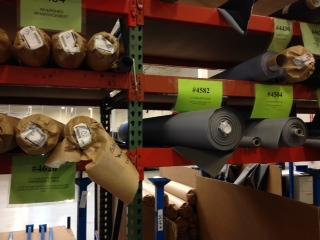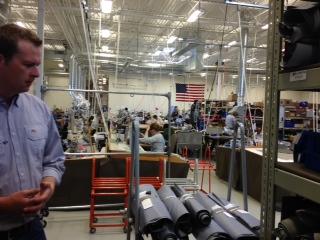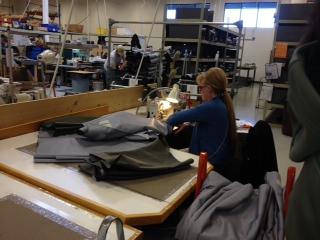Simms waders – a closer look
 We knew that part of our Montana trip had to include a visit to the Simms headquarters in Bozeman. They moved their operations to this new, larger facility a year and a half ago and are already bursting at the seams! If you’ve ever wondered what goes into the making of your Simms wader, this is the place to go and find out.
We knew that part of our Montana trip had to include a visit to the Simms headquarters in Bozeman. They moved their operations to this new, larger facility a year and a half ago and are already bursting at the seams! If you’ve ever wondered what goes into the making of your Simms wader, this is the place to go and find out.
 Our tour began in their Customer Care Center (aka warranty & repair department). Several stations were set up with staff managing each one. As waders and other Simms products come in for repair, they are tagged with customer name and information. The most common reason for wader repair is leakage, so waders are turned inside out and placed on a table. GORE-TEX® waders are sprayed down with isopropyl alcohol and it’s amazing how quickly a few dark spots appear, indicating pin holes that might leak. The Repair Technician put on gloves and gently dabbed some Aquaseal over each dark spot, and smoothed it out in a thin layer.
Our tour began in their Customer Care Center (aka warranty & repair department). Several stations were set up with staff managing each one. As waders and other Simms products come in for repair, they are tagged with customer name and information. The most common reason for wader repair is leakage, so waders are turned inside out and placed on a table. GORE-TEX® waders are sprayed down with isopropyl alcohol and it’s amazing how quickly a few dark spots appear, indicating pin holes that might leak. The Repair Technician put on gloves and gently dabbed some Aquaseal over each dark spot, and smoothed it out in a thin layer.
Nick, our repair center guide, noted that the reinforced areas, such as knees, darken altogether but it doesn’t mean they’re leaking! He sees many pairs with tons of Aquaseal all over that area but the leaks are elsewhere. GORE-TEX® has a unique property where it cannot be chemically altered. Non-Gore waders do not have the same properties so they do not have the same result, may be damaged by alcohol and must be filled with water to find leaks.
Then all repaired waders (as well as new and returned waders) are put through rigorous watertight testing – pressure-filled with water – before heading back to the customer.

Next we entered the Wader Production Floor. This is where new waders are made. They begin with the fabric. All of the GORE-TEX® waders are produced right here in the USA and Simms is one of two GORE-TEX® certified manufacturers in the world and the only one in North America. It’s obviously a point of pride for the employees at Simms as they have a large American flag displayed on the wall. Big bolts of fabric for each type of wader await cutting, stacking, and then form cutting.
 A pattern for each wader part for that fabric and size is laid on the top and bottom of the stack and Clay, the cutting technician, takes a special saw and masterfully cuts each piece.
A pattern for each wader part for that fabric and size is laid on the top and bottom of the stack and Clay, the cutting technician, takes a special saw and masterfully cuts each piece.

Great skill is needed as more than $10,000 worth of material may be on his cutting table at any one time!
Once cut, pieces are put in bins by wader type and size to await sewing together.
At this point, a card is attached to each set of wader parts that will stay with that wader through the entire process. The card is initialed by each person who works on that pair – sewing legs together, adding the belt loops and pockets, sealing seams, adding the bootie foot, etc. This allows Simms to identify problems and resolve problems with materials or skills of workers either during the manufacturing process or if a wader comes back for repair, they know who worked on that part of the process and can resolve any issues. Simms has an incredibly high standard for quality that is seen in every step of their process.
The card is initialed by each person who works on that pair – sewing legs together, adding the belt loops and pockets, sealing seams, adding the bootie foot, etc. This allows Simms to identify problems and resolve problems with materials or skills of workers either during the manufacturing process or if a wader comes back for repair, they know who worked on that part of the process and can resolve any issues. Simms has an incredibly high standard for quality that is seen in every step of their process.
 The waders continue through the sewing area and now begin looking like waders. The next step is the sealing of seams, then a specialized hot and cold press to apply crosspatches on any intersection – sealing these areas especially well and requiring strength and dexterity to operate the required machinery. Accessories, such as pockets and belt loops, are added.
The waders continue through the sewing area and now begin looking like waders. The next step is the sealing of seams, then a specialized hot and cold press to apply crosspatches on any intersection – sealing these areas especially well and requiring strength and dexterity to operate the required machinery. Accessories, such as pockets and belt loops, are added.

Next, we were shown an additional quality control process of seam seal testing with a focused water pressure testing machine, to ensure each batch of sealant meets the standards and keeps waders watertight.
 Booties were the next step in the process. Simms works hard to fit as many sizes as possible and can accommodate most requests for change out of larger or smaller booties in custom waders when needed.
Booties were the next step in the process. Simms works hard to fit as many sizes as possible and can accommodate most requests for change out of larger or smaller booties in custom waders when needed.  Booties are put together like a a puzzle and use a unique hourglass piece that runs along the Achilles heel and up the back for better fit and comfort. The pieces are glued, then a special machine, a pneumatic pincher tool, is used to clamp the pieces together – this is the step that makes the bootie watertight. From there each bootie is taped inside and out to provide additional durability. Then the booties are attached to the waders.
Booties are put together like a a puzzle and use a unique hourglass piece that runs along the Achilles heel and up the back for better fit and comfort. The pieces are glued, then a special machine, a pneumatic pincher tool, is used to clamp the pieces together – this is the step that makes the bootie watertight. From there each bootie is taped inside and out to provide additional durability. Then the booties are attached to the waders.
Then each pair is water tested with high pressure, then dried, tagged, boxed and shelved. Dealers like Angler’s Covey order a shipment, they ship it to us and you come in and pick out your favorite, great-fitting pair!



We found our tour very insightful in the amount of care that goes into each pair of waders. We were also reminded what a great company Simms is with their terrific people, engaging employee culture – including “Fishing Fridays” and “Casting Golf” around the building – and a real desire to see more people enjoying our great sport and being comfortable doing it.

